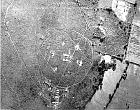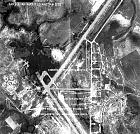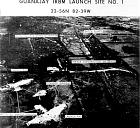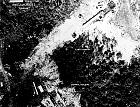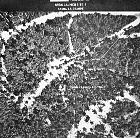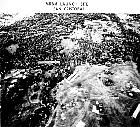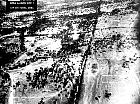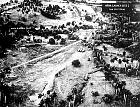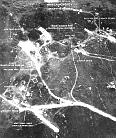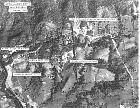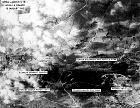CUBA - 1962

Click on images to enlarge
 In April 1961, the United States attempted to invade Cuba and overthrow premier Fidel Castro. On the 17th of April about 1,300 CIA- trained exiles armed with United States weapons landed at Bahia de Cochinos (Bay of
Pigs) on the southern coast of Cuba.
They hoped to gain support from the local populations, cross the island to
Havana, and overthrow Castro. However, they were quickly defeated by Castro's
army. The invasion by the CIA-backed exiles was spurred by the events that took
place after Castro took control of Cuba in January of 1959, Displeased with
Castro's successful military coup, the United States stopped buying Cuban sugar.
Castro responded in 1960 by taking over U.S. oil refineries and all U.S.
businesses in Cuba. This led President Kennedy to authorize the Bay of Pigs
invasion in 1961. US president John F. Kennedy, in meetings with Soviet leader
Nikita KhrushchevŌĆÖs son-in-law Adzhubei in January 1962,
In April 1961, the United States attempted to invade Cuba and overthrow premier Fidel Castro. On the 17th of April about 1,300 CIA- trained exiles armed with United States weapons landed at Bahia de Cochinos (Bay of
Pigs) on the southern coast of Cuba.
They hoped to gain support from the local populations, cross the island to
Havana, and overthrow Castro. However, they were quickly defeated by Castro's
army. The invasion by the CIA-backed exiles was spurred by the events that took
place after Castro took control of Cuba in January of 1959, Displeased with
Castro's successful military coup, the United States stopped buying Cuban sugar.
Castro responded in 1960 by taking over U.S. oil refineries and all U.S.
businesses in Cuba. This led President Kennedy to authorize the Bay of Pigs
invasion in 1961. US president John F. Kennedy, in meetings with Soviet leader
Nikita KhrushchevŌĆÖs son-in-law Adzhubei in January 1962,  compared the US failure at the Bay of Pigs to the Soviet invasion of Hungary in
1956. JFK also assured Adzhubei that the US "will not meddle" with
Cuba, but at the same time, the US Joint Chiefs of Staff were preparing
"cover and deception plans" that included planned pretexts for a US
invasion of Cuba. The PresidentŌĆÖs brother, attorney general Robert F. Kennedy,
compared the US failure at the Bay of Pigs to the Soviet invasion of Hungary in
1956. JFK also assured Adzhubei that the US "will not meddle" with
Cuba, but at the same time, the US Joint Chiefs of Staff were preparing
"cover and deception plans" that included planned pretexts for a US
invasion of Cuba. The PresidentŌĆÖs brother, attorney general Robert F. Kennedy,
 was simultaneously leading discussions with the CIA and Pentagon about covert
operations (codenamed Operation Mongoose) on the proposition that "a solution
to the current Cuban problem carried ŌĆśthe top priority in the United States
governmentŌĆ”.These proposals - part of a secret anti-Castro program known as
Operation Mongoose - included staging the assassinations of Cubans living in the
United States, developing a fake "Communist Cuban terror campaign in the
Miami area, in other Florida cities and even in Washington," including
"sink[ing] a boatload of Cuban refugees (real or simulated),ŌĆØ faking a
Cuban airforce attack on a civilian jetliner, and concocting a "Remember the
Maine"Ø incident by blowing up a U.S. ship in Cuban waters and then blaming the
incident on Cuban sabotage.
was simultaneously leading discussions with the CIA and Pentagon about covert
operations (codenamed Operation Mongoose) on the proposition that "a solution
to the current Cuban problem carried ŌĆśthe top priority in the United States
governmentŌĆ”.These proposals - part of a secret anti-Castro program known as
Operation Mongoose - included staging the assassinations of Cubans living in the
United States, developing a fake "Communist Cuban terror campaign in the
Miami area, in other Florida cities and even in Washington," including
"sink[ing] a boatload of Cuban refugees (real or simulated),ŌĆØ faking a
Cuban airforce attack on a civilian jetliner, and concocting a "Remember the
Maine"Ø incident by blowing up a U.S. ship in Cuban waters and then blaming the
incident on Cuban sabotage.
According to Nikita Khrushchev's memoirs, in May 1962 he conceived the idea of
placing intermediate range missiles in Cuba as a means of countering an emerging
lead of the United States in developing and deploying missiles. He also
presented the scheme as a means of protecting Cuba from another United States
sponsored invasion, such as the failed attempt at the Bay of Pigs in 1961.With
Castro's approval, the Soviet Union began building secret missile bases in Cuba.
Tony Martinez, Operations Officer for all the flights out of McCoy was Sqdn
Commander of the USAF U-2 Squadron based at Del Rio,TX at Laughlin AFB. The
first Cuban overflight was flown by USAF U-2 pilot Capt Steve Heyser departing
out of Edwards AFB, CA in a U-2C. Subsequently, ten other pilots from Laughlin
flew the Cuban mission. An October 14, 1962 U-2 mission provided conclusive
proof that the Soviet Union was deploying medium-range ballistic missiles to
Cuba. On October 16, 1962, CIA analysts briefed President John F. Kennedy on
what is probably the most  famous overhead reconnaissance photograph of all time. The image - snapped
from 70,000 feet by a U-2 reconnaissance aircraft - proved conclusively that the
Soviet Union was installing medium-range ballistic missiles in Cuba, touching
off the most dangerous episode of the Cold War: The Cuban Missile Crisis.
famous overhead reconnaissance photograph of all time. The image - snapped
from 70,000 feet by a U-2 reconnaissance aircraft - proved conclusively that the
Soviet Union was installing medium-range ballistic missiles in Cuba, touching
off the most dangerous episode of the Cold War: The Cuban Missile Crisis.
On October 22, President Kennedy responded by televising an address stating the
discovery of the weapons and that any attack coming from Cuba would be treated
as an attack from the Soviet Union and would be treated accordingly. In
addition, he imposed a naval blockade of Cuba to stop the construction of the
sites.
On October 26, Khrushchev sent a letter to Kennedy suggesting that the sites
would be dismantled if the United States gave its reassurance that it would not
invade Cuba. Following up on this suggestion, on October 28, Khrushchev
announced that the sites would be dismantled; as well as the removal of light
bombers. The United States agreed and responded to the specific conditions of
assurances for the United States not to invade Cuba. Worldwide, elements were
diverted to support the U-2 flights over Cuba. Pilots flying out of Upper
Heyford were brought back to the CONUS to fly U-2 missions over Cuba as the U.S.
carefully monitored Soviet implementation of their promise to dismantle and
remove all Soviet missiles from Cuba. Many of the pilots involved in the Cuban
missile crisis later became known as "Roadrunners" because of their
affiliation and participation in SR aircraft development flights at Groom Lake,
Nevada. The following photos demonstrate the effectiveness of the CIA and Air
Force surveillance planes and these future Roadrunners in exposing the
aggression of the Soviet Union and Cuba that brought the world to the brink of
nuclear war.
Click on images to enlarge
© Copyright 2001-, Dreamland Resort. All rights reserved. See a broken link or error - please email the webmaster. Page last modified 09/08/2021









 In April 1961, the United States attempted to invade Cuba and overthrow premier Fidel Castro. On the 17th of April about 1,300 CIA- trained exiles armed with United States weapons landed at Bahia de Cochinos (Bay of
Pigs) on the southern coast of Cuba.
They hoped to gain support from the local populations, cross the island to
Havana, and overthrow Castro. However, they were quickly defeated by Castro's
army. The invasion by the CIA-backed exiles was spurred by the events that took
place after Castro took control of Cuba in January of 1959, Displeased with
Castro's successful military coup, the United States stopped buying Cuban sugar.
Castro responded in 1960 by taking over U.S. oil refineries and all U.S.
businesses in Cuba. This led President Kennedy to authorize the Bay of Pigs
invasion in 1961. US president John F. Kennedy, in meetings with Soviet leader
Nikita KhrushchevŌĆÖs son-in-law Adzhubei in January 1962,
In April 1961, the United States attempted to invade Cuba and overthrow premier Fidel Castro. On the 17th of April about 1,300 CIA- trained exiles armed with United States weapons landed at Bahia de Cochinos (Bay of
Pigs) on the southern coast of Cuba.
They hoped to gain support from the local populations, cross the island to
Havana, and overthrow Castro. However, they were quickly defeated by Castro's
army. The invasion by the CIA-backed exiles was spurred by the events that took
place after Castro took control of Cuba in January of 1959, Displeased with
Castro's successful military coup, the United States stopped buying Cuban sugar.
Castro responded in 1960 by taking over U.S. oil refineries and all U.S.
businesses in Cuba. This led President Kennedy to authorize the Bay of Pigs
invasion in 1961. US president John F. Kennedy, in meetings with Soviet leader
Nikita KhrushchevŌĆÖs son-in-law Adzhubei in January 1962,  compared the US failure at the Bay of Pigs to the Soviet invasion of Hungary in
1956. JFK also assured Adzhubei that the US "will not meddle" with
Cuba, but at the same time, the US Joint Chiefs of Staff were preparing
"cover and deception plans" that included planned pretexts for a US
invasion of Cuba. The PresidentŌĆÖs brother, attorney general Robert F. Kennedy,
compared the US failure at the Bay of Pigs to the Soviet invasion of Hungary in
1956. JFK also assured Adzhubei that the US "will not meddle" with
Cuba, but at the same time, the US Joint Chiefs of Staff were preparing
"cover and deception plans" that included planned pretexts for a US
invasion of Cuba. The PresidentŌĆÖs brother, attorney general Robert F. Kennedy,
 was simultaneously leading discussions with the CIA and Pentagon about covert
operations (codenamed Operation Mongoose) on the proposition that "a solution
to the current Cuban problem carried ŌĆśthe top priority in the United States
governmentŌĆ”.These proposals - part of a secret anti-Castro program known as
Operation Mongoose - included staging the assassinations of Cubans living in the
United States, developing a fake "Communist Cuban terror campaign in the
Miami area, in other Florida cities and even in Washington," including
"sink[ing] a boatload of Cuban refugees (real or simulated),ŌĆØ faking a
Cuban airforce attack on a civilian jetliner, and concocting a "Remember the
Maine"Ø incident by blowing up a U.S. ship in Cuban waters and then blaming the
incident on Cuban sabotage.
was simultaneously leading discussions with the CIA and Pentagon about covert
operations (codenamed Operation Mongoose) on the proposition that "a solution
to the current Cuban problem carried ŌĆśthe top priority in the United States
governmentŌĆ”.These proposals - part of a secret anti-Castro program known as
Operation Mongoose - included staging the assassinations of Cubans living in the
United States, developing a fake "Communist Cuban terror campaign in the
Miami area, in other Florida cities and even in Washington," including
"sink[ing] a boatload of Cuban refugees (real or simulated),ŌĆØ faking a
Cuban airforce attack on a civilian jetliner, and concocting a "Remember the
Maine"Ø incident by blowing up a U.S. ship in Cuban waters and then blaming the
incident on Cuban sabotage. famous overhead reconnaissance photograph of all time. The image - snapped
from 70,000 feet by a U-2 reconnaissance aircraft - proved conclusively that the
Soviet Union was installing medium-range ballistic missiles in Cuba, touching
off the most dangerous episode of the Cold War: The Cuban Missile Crisis.
famous overhead reconnaissance photograph of all time. The image - snapped
from 70,000 feet by a U-2 reconnaissance aircraft - proved conclusively that the
Soviet Union was installing medium-range ballistic missiles in Cuba, touching
off the most dangerous episode of the Cold War: The Cuban Missile Crisis.






















































